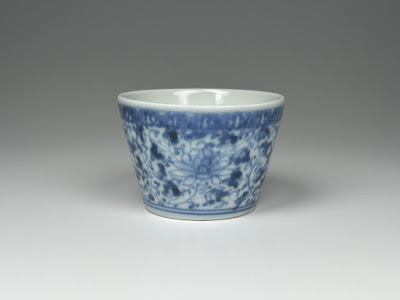そば猪口形の小さな猪口 Small Bucket-shaped Imari Cups
そば猪口をぎゅっと縮めたような、バケツ形の小さな猪口がある。芽猪口、姫猪口、豆猪口などと呼ばれる。量産されたものではなく、そば猪口やのぞき猪口なんかに比べれば数はずっと少ない。
The following old Imari wares can be classified as small "bucket-shaped" cup that is much rarer than soba-choko and nozoki-choko.
1. 花唐草文 Flower Arabesque
口径 top width: 60 mm / 高さ height: 40 mm / 高台径 bottom width: 42 mm
この花唐草文様は江戸中期頃相当はやったようで、これと双璧をなす蛸唐草とともに古伊万里を代表する絵柄と言えよう。現代の古美術市場でもたいへん人気がある。ただそれゆえにこそ、これはと言えるようなきれいな花唐草文の器はなかなか見かけないし、あってもかなり高価である。この猪口も呉須がにじんでしまっていて、お世辞にもていねいな絵付けとはいえない。器自体はたいへん薄造りで、光が透けるほどである。
"Hana-karakusa" (flower arabesque pattern) was very popular in the mid Edo period. Hana-karakusa and another popular pattern "tako-karakusa" (octopus arabesque) are probably the best known old Imari designs and they are highly rated in modern antique markets. That means it is difficult to find well-drawn hana-karakusa cups at a reasonable price. Actually, I can't say this example is a first-class Imari as the blue lines are blurred. The body is, however, transparently thin and well made.
2. 氷裂文 Broken Ice
口径 top width: 59 mm / 高さ height: 35 mm / 高台径 bottom width: 38 mm
氷裂文様も江戸中期〜後期を代表する人気のあった絵柄だ。この猪口も前のと同様呉須がながれていてピンぼけ写真みたいだ。また何本か縦にひび割れが生じている。器の裏側まではひびが通っていない地貫(じかん)とよばれるものだが、ちょっと残念である。
Broken ice pattern was also popular in the mid to late Edo periods. The drawing on this cup is also not good, and there are some cracks that go just the outermost part of the body.
補足
このタイプの小猪口はすでに松竹梅文様のを紹介済み。花唐草、氷裂、松竹梅。これら3種に共通するのは、いずれも古伊万里の猪口としては当時もっとも人気のあった絵柄たちだということである。またつくりがとてもていねいだ(絵付けは雑だが)。サンプル数がたった3個なのでなんとも言えないが、このタイプの逆台形小猪口が実用のためではなく、一種の飾り、あるいは雛道具のようなものとしてつくられたのかもしれない、と想像したりする。当時の人々が思い描くいわゆる「そば猪口」をちょっと小さくつくって、宴席の遊びとしてこういう猪口をつかったかもしれない。現代の感覚からすると伊万里の猪口の中でも酒器としてつかうにはもっとも適している。
I have already shown another example that belongs to this bucket-type cup (see photos below). The patterns of these three examples were all popular and typical of the Imari wares in the Edo period. I guess that this type of Imari cup is a kind of miniature of soba-choko that was mass-produced for daily use. People in the Edo period might use this small cup at a banquet for amusement.






